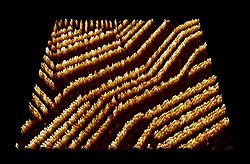
Back علم السطوح Arabic Физикохимия на повърхностите Bulgarian Overfladevidenskab Danish Ciencia de superficies Spanish علم سطح Persian Science des surfaces French पृष्ठ रसायन Hindi Ilmu permukaan ID Scienza delle superfici Italian 表面科学 Japanese

Surface science is the study of physical and chemical phenomena that occur at the interface of two phases, including solid–liquid interfaces, solid–gas interfaces, solid–vacuum interfaces, and liquid–gas interfaces. It includes the fields of surface chemistry and surface physics.[1] Some related practical applications are classed as surface engineering. The science encompasses concepts such as heterogeneous catalysis, semiconductor device fabrication, fuel cells, self-assembled monolayers, and adhesives. Surface science is closely related to interface and colloid science.[2] Interfacial chemistry and physics are common subjects for both. The methods are different. In addition, interface and colloid science studies macroscopic phenomena that occur in heterogeneous systems due to peculiarities of interfaces.
- ^ Prutton, Martin (1994). Introduction to Surface Physics. Oxford University Press. ISBN 978-0-19-853476-1.
- ^ Luklema, J. (1995–2005). Fundamentals of Interface and Colloid Science. Vol. 1–5. Academic Press.
© MMXXIII Rich X Search. We shall prevail. All rights reserved. Rich X Search